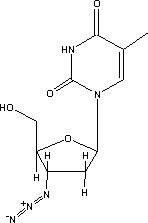Zidovudine is supplied most commonly in film-coated tablets (300 mg, biconvex, round and white) with "GXCW3" on one side and "300" on the other. The drug also comes in capsules (100 mg), flavored syrup, and an intravenous infusion. Dosing may vary.
"The confirmed reports of drug-resistance involve only a few patients so far, and doctors who are prescribing AZT to fight the infection stress that they see no reason to stop administering the drug."
San Francisco Chronicle, March 15, 1989
Also known as: azidothymidine, AZT
Background and description. Zidovudine was approved by the US Food and Drug Administration (FDA) in March 1987 as the first antiretroviral to treat HIV disease. The drug is manufactured and distributed by Glaxo Wellcome. Zidovudine is a nucleoside reverse transcriptase inhibitor (NRTI). In combination with other antiretroviral agents, zidovudine can be effective in suppressing viral replication.
Guidelines classification. The Panel on Clinical Practices for the Treatment of HIV Infection classifies zidovudine as "strongly recommended" when used in combination with lamivudine (Epivir) or didanosine (Videx).
Dose. The recommended dose for zidovudine in adults is 300 mg twice a day.
Food restrictions. Zidovudine can be taken with or without food.
Storage. Tablets and capsules should be stored at a temperature of 59 [degrees] to 77 [degrees] F. Capsules should be protected from moisture.
Side effects and toxicity. Zidovudine can suppress bone marrow production of blood cells (hematologic toxicity), resulting in anemia or neutropenia. In patients with neutrophil counts less than 1000 cells/[mm.sup.3] or hemoglobin levels less than 9.5 g/dL, zidovudine should be used with caution. Special care should be taken when administering the drug to patients with advanced HIV disease or other conditions characterized by anemia or neutropenia. Lactic acidosis and severe hepatomegaly (enlarged liver) with steatosis (fatty liver) are rare, but potentially fatal, and have been associated with NRTI use. Additionally, some complaints of gastrointestinal intolerance (pain, nausea and diarrhea), headache, insomnia and asthenia (weakness) have been documented. Myopathy (muscle wasting) and myositis (muscle inflammation), similar to that produced by HIV itself, have been associated with prolonged use of zidovudine. As a class, NRTIs have been implicated in damage to mitochondrial DNA and may therefore play a role in the development of metabolic and morphologic abnormalities.
Drug interactions. Because of hematologic toxicity, caution should be used when co-administering zidovudine with bone marrow suppressive agents or interferon alpha. Dose reduction or interruption of one or more agents may be necessary; frequent hematologic monitoring is recommended. Ribavirin should be avoided in combination with zidovudine, since it inhibits phosphorylation of zidovudine during metabolism.
Resistance and cross-resistance. Zidovudine resistance is associated with mutations at positions 41, 67, 70, 215 and 219. In general, a greater number of mutations confers greater resistance, with the 215 mutation being most significant. Cross-resistance can occur with other NRTIs. A mutation at position 333 confers resistance to both zidovudine and lamivudine. A mutation at position 151 is associated with resistance to the entire NRTI class. An insertion at position 69 can also lead to broad NRTI resistance.
Clinical data. Early use of zidovudine showed some effect on viral replication resulting in approximately a 0.6 log drop in viral load. This effect was short-lived when zidovudine was used as monotherapy. Other studies showed the efficacy of zidovudine in combination with another NRTI, such as lamivudine, and a protease inhibitor. The START 1 study looked at stavudine(Zerit)/lamivudine/indinavir (Crixivan) compared to zidovudine/lamivudine/indinavir in antiretroviral naive subjects. Out to 24 weeks, both arms performed equally well in decreasing viral load to less than 500 copies/mL. The START 2 study compared regimens of stavudine/didanosine/indinavir versus zidovudine/ lamivudine/indinavir in antiretroviral treatment naive subjects. The percentages of subjects in each arm with viral loads less than 500 copies/mL at 24 weeks were 68% and 77% respectively.
Zidovudine therapy is the current standard in preventing vertical transmission (mother to child) of HIV. In a study of pregnant women, ACTG 076, the estimated risk of mother-to-child transmission of HIV was less than 8% in zidovudine-treated infants (antenatal, perinatal, and neonatal drug administration) versus almost 25% in the placebo group.
Patient assistance. For those who qualify, Glaxo Wellcome offers a patient assistance program. For more information, call 800.722.9294.
COPYRIGHT 2000 The Center for AIDS: Hope & Remembrance Project
COPYRIGHT 2000 Gale Group



